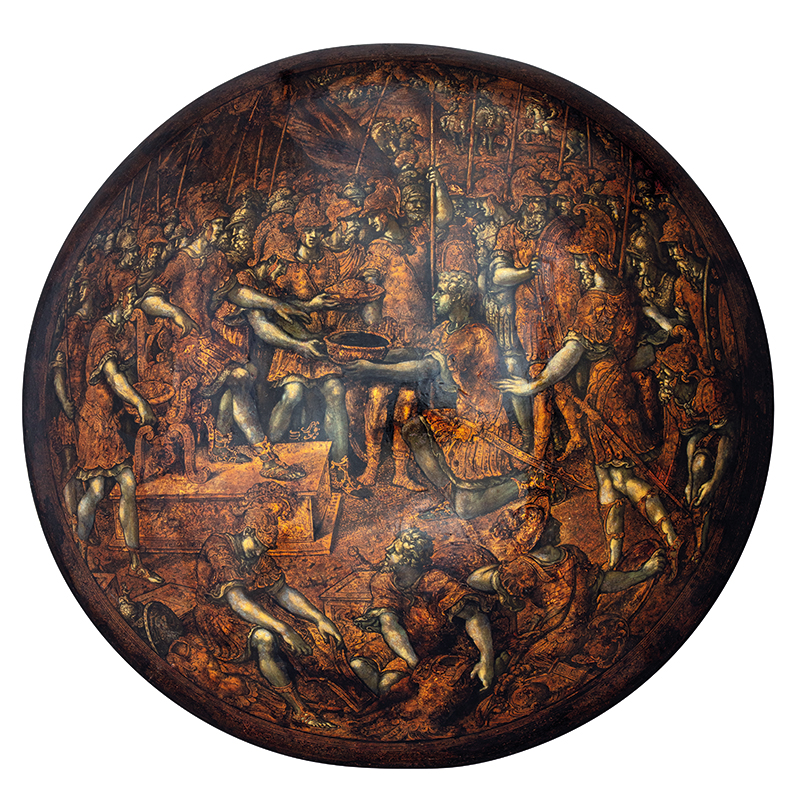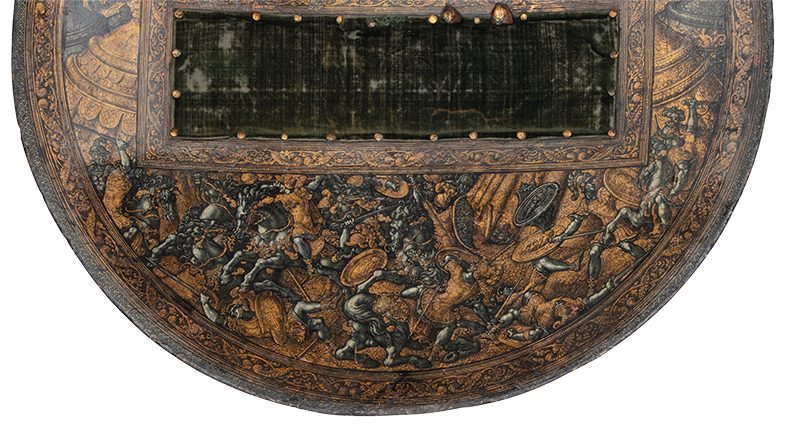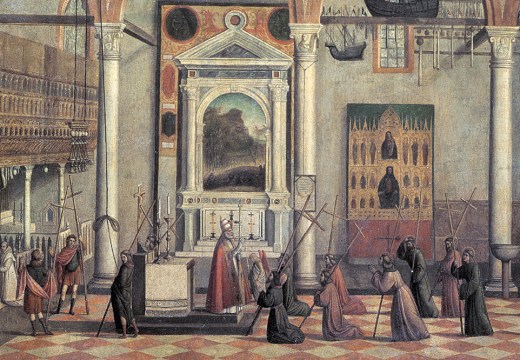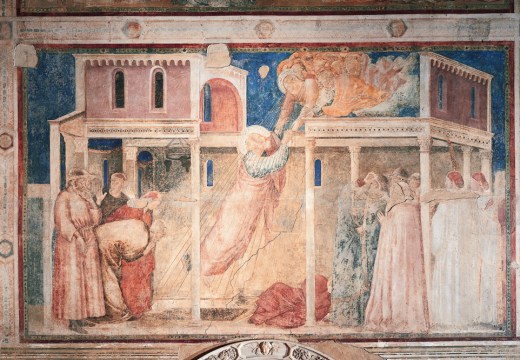From the May 2022 issue of Apollo. Preview and subscribe here.
Pierre Terjanian of the Metropolitan Museum of Art tells Apollo about the groundbreaking research by his predecessor Stuart W. Pyhrr that revealed why a Renaissance pageant shield in the museum’s collection is such a beguiling work of art.
This shield attributed to Girolamo da Treviso (c. 1498–1544) was not meant to function on its own, but was designed as part of a suite. About six of these very closely related shields are known to have survived; they were made around 1535 for use in pageants, so it is a processional shield. (Our understanding of this shield is indebted to the work of Stuart W. Pyhrr, Everett Fahy and Melissa S. Meighan.)
The shield and its companions all appear to have been part of the Medici armoury, which was dispersed around 1775. However, it is not clear whether they were commissioned by a Medici or by a della Rovere, as the Medici armoury absorbed the Rovere one in 1631 and the record of what could be these shields appears only in an inventory made after this amalgamation.
It seems that such shields were all made following the same technique. Three layers of thin wooden board are overlaid at right angles to one another, then held together by metal staples. This is covered in linen, which is then covered by layers of gesso. The outer side at least – but possibly the inner side as well – is covered entirely in gold leaf and over-painted with figures. The flesh of the figures is in grisaille, with black pigment highlights on the gold ground. Using sgraffito – a scraping technique – the painted layers are partly removed to expose the gold beneath it and form the image. Sgraffito and grisaille are rather unusual for the period, and almost a hallmark of da Treviso’s work.

Shield, c. 1535, attributed to Girolamo da Treviso. Metropolitan Museum of Art, New York
The composition is very dense, with a sense of space only beyond the foreground, to call attention to the figure of a commander who is seated, receiving bowls, carried by three attendants, that look like tributes or gifts of some kind. One of the shields in the series is clearly based on a drawing (or a copy of it) by Giulio Romano from a tapestry cycle depicting the history of Scipio, which was commissioned by Francis I of France and completed by 1532. The tapestries themselves, woven in Brussels, were destroyed during the French Revolution, but copies of Romano’s designs, probably made in his workshop, were circulated. In this instance, we cannot connect the composition to one particular drawing. We know from looking at the composition of other shields in the group that there are multiple sources of inspiration. And even when the source is recognisable as, for instance, a Giulio Romano drawing, the artist made some changes to fit the composition into a circle rather than a rectangle – things are somewhat rearranged and reinvented, especially around the perimeter.
The scene looks like a typical reference to the ancient practice of paying tribute to a sovereign, in acknowledgement of their supremacy. But in the foreground are a number of figures examining armour: this looks less like tribute than booty. Given the connection with Giulio Romano’s drawings, it seems as if these shields represent the history of the Second Punic War, when Rome was in an existential struggle with Carthage. Rome was nearly destroyed in the process, but the war ended with a Roman victory. This may be, for example, a scene that follows the capture and destruction of New Carthage by the Roman commander, so war booty is being brought to him as part of the victory celebrations. On the interior, the decoration shows an encampment being stormed, a scene that may refer to a specific episode of the war as described by Livy.
The interiors of most of the shields in the series are also painted with battle scenes. What is interesting is that the rectangle in the centre – which is where the enarmes (the straps used to carry the shield) and padding for the arm would go – interrupts the scene completely; there is no attempt to build around the necessary cartouche in the centre of the shield. Instead, it is almost superimposed. That is something that we see on all the shields in this group. What is important compositionally is the clear difference in scale between the interior and the exterior of the shield: the exterior is meant to be intelligible from a distance. However, the interior is painted with such detail and such density that only the person carrying the shield could have actually read the scene. Therefore, given the luxury and the amount and quality of the work that went into the interior decoration, it seems likely that those shields would have been carried only by people of note – perhaps by noblemen participating in a triumphal procession based on the Roman model.

Only the person carrying the shield could have seen the rich decoration of its interior
The work that goes into the borders, on the interior and the exterior, is a reminder that a huge amount of care went into the creation of each shield. We believe the shields were painted by the same hand, and the painter could have used a pattern, but in the end, there is still an urge to make each one unique in some way.
It is very unlikely that the shields would have been used more than once. To contextualise this, there was a tradition, particularly in 16th-century Italy, of making round shields that were painted both inside and outside. There were clearly different workshops involved, and varying levels of quality. These shields found a home as far afield as England, Spain and Germany, and would turn up on mid-16th century inventories here and there. The group that we are discussing is among the most sophisticated of the ones known, and perhaps the most exclusive, in the sense that they were likely commissioned for one event, and kept as a memento of that event. Allegory is such an important framework in the Renaissance: all the references to the ancient world that dominate both the interior and the exterior of the shield not only turn the carrier into an ancient Roman figure and connect them to the dignity and the glory of ancient Roman commanders, but they also, perhaps, refer to Charles V’s campaign in North Africa, when he subjugated Tunis, where the Ottomans had a large fleet that periodically raided his Mediterranean dominions. On his return, Charles landed in Sicily and made a triumphal procession all the way through Italy. He was greeted everywhere as a new Scipio, the Roman general who defeated the Carthaginians at Zama, because he had put an end to the piracy coming from the Barbary coast, although that didn’t last. So it is possible that these shields were commissioned for his entry into one of the Italian states – Urbino or Tuscany – following that campaign.
The shield in the Met belonged to the Anglo-French painter Philip James Loutherbourg (1740–1812). There are two closely related shields in the Louvre which belonged to Everhard Jabach (1618–95), whose collection was acquired by Louis XIV in 1671. The Met recently acquired a large-scale painting of Jabach and his collection, which features all the foundational pieces that were the nucleus of the Louvre’s collection. Another shield in the group, which remains in Arundel Castle, belonged to Thomas Howard (1585–1646), who was a great art collector; it even features in a family portrait dating from 1646 which is still in the castle. Clearly these shields were prized as works of art as early as the 17th century, and the way that they were displayed shows that this is a good example of arms being prized not just as historical mementos or relics of the glorious past but for their intrinsic qualities – because they were beautifully made, they display creative ingenuity. In 1681, the painter Charles Le Brun (1619–90) already suggested an attribution to Giulio Romano of the shields that are now in the Louvre.
These objects are a reminder that arms are not always made of metal, and that the manufacture and the decoration of arms was not always within the purview of a narrow group of specialists. On the contrary, arms invited contributions from a wide range of artists – in this case the intriguing figure of da Treviso, who was not just a painter but a well-trained engineer and an architect. Such people tend to be better remembered for their contributions to other areas than the decoration of shields or arms. But for this is a harbinger of the recognition that so many armours and weapons in the Met’s collection command today. These shields are some of the earliest evidence that we have of the reappraisal of the artistic merits of arms – something for which armour would have to wait until the beginning of the 19th century.
As told by Pierre Terjanian, curator in charge of arms and armour at the Metropolitan Museum of Art, New York, to Edward Behrens.
From the May 2022 issue of Apollo. Preview and subscribe here.
Unlimited access from just $16 every 3 months
Subscribe to get unlimited and exclusive access to the top art stories, interviews and exhibition reviews.














![Masterpiece [Re]discovery 2022. Photo: Ben Fisher Photography, courtesy of Masterpiece London](http://www.apollo-magazine.com/wp-content/uploads/2022/07/MPL2022_4263.jpg)
Why are fathers so absent from art history?